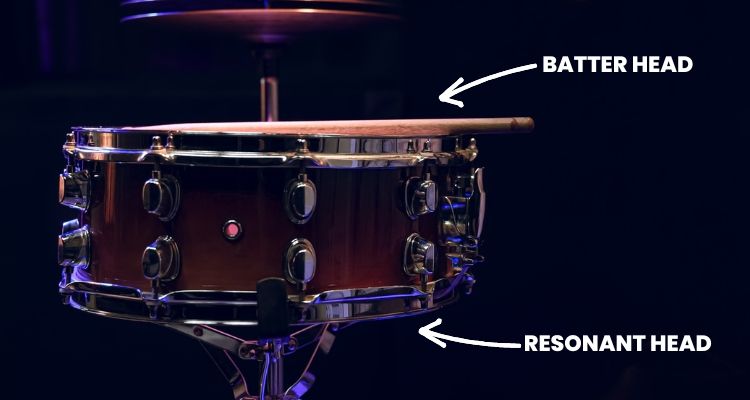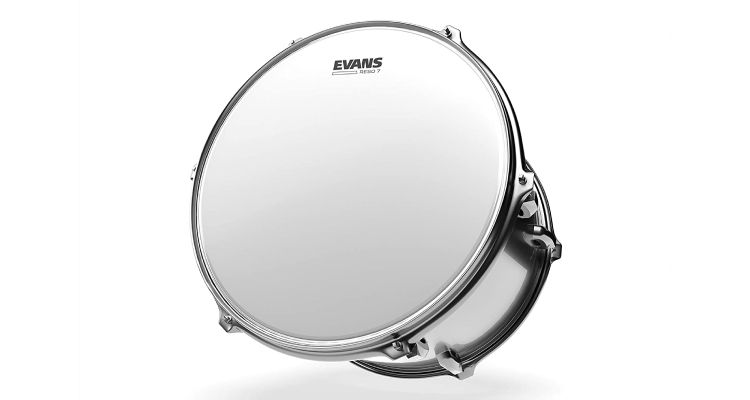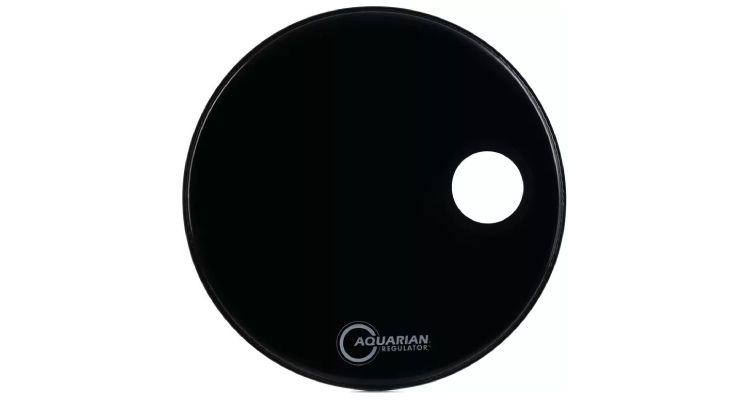When thinking about drumheads, most people tend to focus on batter heads, and resonant heads tend to be forgotten a lot of the time. The thing is, your resonant heads play a massive role in shaping your drum sounds, so you should understand how they work and how to get them to work in your favor.
In this guide, I’m going to explain everything there is to know about resonant heads. I’ll break down all the different types, and I’ll suggest a few of my favorite ones for you to check out.
Contents
What is a Resonant Drum Head?
Resonant drumheads are the drumheads that fit onto the bottom sides of all your drums. When thinking of batter vs resonant drum heads, most drummers completely forget about the resonant heads, as they’re always out of sight.

Resonant heads control how much your drums resonate. It’s all in the tone.
While batter heads mostly control how your drums feel, resonant heads play the biggest role in determining how your drums sound.
Do you want your drums to sing and ring out? You need to have certain types of resonant heads, and you need to tune them very specifically for that. Do you want your drums to have no resonance with a flat sound? You’ll need slightly different resonant drumheads for that.
The batter heads still have a big influence over sound, but the resonant heads establish what you hear after you strike the drums, while the batter heads establish what you hear as you strike them.
Different Types of Resonant Drum Heads
Thin Resonant Heads
Thin resonant heads cause fewer vibrations to occur inside the drums when you strike them. This leads to shorter sustain. The thin heads have less mass, so you don’t get as much movement from the energy transferring from the batter head to the resonant head.
A thin kick drum resonant head will have the shortest sound compared to any other type of resonant head, and you’ll find the same thing happening with every other type of drum.
However, something to take note of is that most resonant drumheads are thin compared to batter heads, so don’t take the thickness of batter heads into account when looking at resonant heads.
If you put thin resonant heads on your drums, you’re going to get a very dry sound. Your drums won’t ring for too long, and that’s a sound that a lot of drummers go for.
Thick Resonant Heads
Thicker resonant heads have more mass, and that leads to more vibrations occurring inside the drums whenever you strike them. With more vibrations occurring, the sounds of the drums ring out for longer. This leads drums with thick resonant heads to have more sustain.
This also leads to more overtones. Some drummers like the sound of those, but most drummers don’t. So, keep that in mind when picking resonant drumheads. If you have thick resonant heads, you have to be very accurate with your tuning to stop those overtones from being overbearing.
Otherwise, you’ll need to muffle your drums a bit more, but that will defeat the purpose of having thicker heads for longer sustain.
A classic example of drums that benefit from thick resonant heads would be kits that are used for playing jazz. Jazz kits are tuned high, and the toms are always set up so that they have musical sustain. It’s easier to achieve those tones with thick resonant heads.
Kick Drum Resonant Head
When looking at kick drum resonant drumheads, you have two very distinct options. Some of them are designed the same way as all other resonant heads, while others have built-in kick drum port holes so that you can place a microphone inside the kick drum.
The kick drum ports don’t affect the tone drastically, so you still get the same effect depending on how thick or thin the resonant head is. Some drummers also cut their own kick drum ports into their heads.
With that being said, you get slightly more resonance from the kick drum if there isn’t a port, so you’ll hardly ever see jazz drummers playing kick drums with them.
If you want a thick and deep kick drum sound that is fairly flat with no overtones, it won’t matter if you have a ported kick drumhead or not. You’ll need muffling to get that sound, and it will actually be easier to apply muffling if you do have a port hole.
Clear vs Coated Bottom Drum Heads
The clear vs coated debate also exists with resonant drum heads. You’ll find both types available, with most drummers using clear drumheads at the bottom.
The biggest reason for this is that almost every drum kit that you buy will come with clear drumheads. Since most drummers don’t worry about resonant heads, they keep the clear ones that came with their kit.
If you put a coated drum head at the bottom of your drum, you’ll get tones that are slightly warmer. These heads are a bit more controlled, having fewer overtones compared to clear drum heads.
Coated heads won’t resonate as much as clear heads, though, so they’re not always the best choice.
2-Ply Heads with Built-In Muffling
Some resonant drumheads come with built-in muffling. This lowers the number of overtones you get even more, and they’re a great choice for drummers who want the driest drum sounds that they can possibly get.
You also have the option of using two-ply heads as resonant heads. Typically, those two-ply heads would be designed to be used as batter heads, but using them as resonant heads will give you unique sounds that are dry and resemblant to drums from the 60s.
There’s a big difference between thick single-ply heads and two-ply heads. You get a lot of sustain from thick single-ply heads due to their mass causing more vibrations. While two-ply heads are even thicker, the second layer always stops those vibrations, and that’s what dries the drum sound out.
Best Resonant Drum Heads
Snare Drum

When choosing a resonant head for a snare drum, you need to make sure that you’re getting a thin one. The thicker the head is, the less interplay you’ll get between the head and the snare wires. That will take away a lot of the sensitivity of the snare. So, thin snare heads are always the best.
You mostly get 2-mil and 3-mil snare side heads. 3-mil heads will have slightly less sensitivity, but they’ll be more durable. You’ll also find 5-mil heads, but I’d suggest skipping those.
Every drumhead brand sells dedicated snare drum resonant heads. Those will always be your best options, as they’re designed specifically to work well with snare wires.
Here are a few fantastic options:
- Evans 200 Snare Side Drumhead
- Remo Ambassador Clear Snare Side Drumhead
- Aquarian Clear Classic Snare Side Drumhead
Toms

Tom heads are where you’ll find the most variety of choices. There are so many options out there, and many drummers simply just use the stock resonant heads that came with their kit.
Everything I mentioned above applies mostly to resonant tom drumheads. So, thicker ones will give you more resonance, thinner ones will offer flatter sounds, and 2-ply and coated heads will offer the most controlled tom tones.
Here are the most popular resonant heads for toms:
Bass Drum

When it comes to bass drum heads, the one that you currently have on your bass drum should be fine, especially if you already have muffling inside the shell. The muffling will cancel out the tonal effect of the resonant head.
I’d only suggest getting a new bass drum resonant head if you want a bass drum head with a port hole.
Here are the best options for that:
- Aquarian Regulator Ported Black Glass Bass Drumhead
- Evans EQ3 Resonant Black Bass Drumhead
- Remo Powerstroke P3 Ebony Drumhead
How to Tune Resonant Drumheads
When tuning a bottom drum head, you have the option of tuning it higher, lower, or the same compared to how you’ve tuned the batter head.
You should tune your batter heads first, as that will give the base of what you’re going for with all your drums. Then you can move onto the resonant heads.
If you tune the resonant heads lower than the batter heads, the looser tension will cause fewer vibrations. This will give you a flatter and more controlled sound from the drums.
If you tune your resonant heads higher than the batter heads, you’ll get brighter sounds from the drums with slightly more resonance.
You’ll get the most resonance out of the drums when you tune the batter and resonant heads with the same tension.
Conclusion
Are resonant heads as important as batter heads? Not quite, as you’ll get better tones from your drums with an appropriate set of batter heads. However, you’ll be able to fine-tune your drums to sound the best that they possibly can when you get a good set of resonant heads as well.
While the tonal differences are slight compared to batter heads, you’ll be amazed at what a good set of resonant heads can do. The benefit of buying a set of resonant heads is that you don’t need to replace them as often as you do with batter heads.









